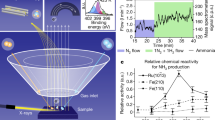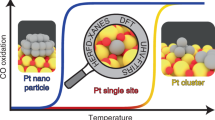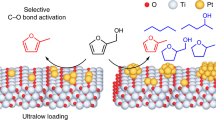Abstract
MoO3 and Mo2C have emerged as remarkable catalysts for the selective hydrodeoxygenation (HDO) of a wide range of oxygenates at low temperatures (that is, ≤673 K) and H2 pressures (that is, ≤1 bar). Although both catalysts can selectively cleave C–O bonds, the nature of their active sites remains unclear. Here we used operando near-ambient pressure X-ray photoelectron spectroscopy to reveal important differences in the Mo 3d oxidation states between the two catalysts during the hydrodeoxygenation of anisole. This technique revealed that, although both catalysts featured a surface oxycarbidic phase, the oxygen content and the underlying phase of the material impacted the reactivity and product selectivity during the hydrodeoxygenation. MoO3 transitioned between 5+ and 6+ oxidation states during the operation, consistent with an oxygen-vacancy driven mechanism wherein the oxygenate is activated at undercoordinated Mo sites. In contrast, Mo2C showed negligible oxidation state changes during hydrodeoxygenation and maintained mostly 2+ states throughout the reaction.
This is a preview of subscription content, access via your institution
Access options
Access Nature and 54 other Nature Portfolio journals
Get Nature+, our best-value online-access subscription
$29.99 / 30 days
cancel any time
Subscribe to this journal
Receive 12 digital issues and online access to articles
$119.00 per year
only $9.92 per issue
Buy this article
- Purchase on Springer Link
- Instant access to full article PDF
Prices may be subject to local taxes which are calculated during checkout



Similar content being viewed by others
Data availability
All data are available from the corresponding author upon reasonable request.
References
Furimsky, E. Catalytic hydrodeoxygenation. Appl. Catal. A 199, 147–190 (2000).
Huber, G. W., Iborra, S. & Corma, A. Synthesis of transportation fuels from biomass: chemistry, catalysts, and engineering. Chem. Rev. 106, 4044–4098 (2006).
Choudhary, T. & Phillips, C. Renewable fuels via catalytic hydrodeoxygenation. Appl. Catal. A 397, 1–12 (2011).
Bu, Q. et al. A review of catalytic hydrodeoxygenation of lignin-derived phenols from biomass pyrolysis. Bioresour. Technol. 124, 470–477 (2012).
He, Z. & Wang, X. Hydrodeoxygenation of model compounds and catalytic systems for pyrolysis bio-oils upgrading. Catal. Sustainable Energy 1, 28–52 (2012).
Ruddy, D. A. et al. Recent advances in heterogeneous catalysts for bio-oil upgrading via ‘ex situ catalytic fast pyrolysis’: catalyst development through the study of model compounds. Green Chem. 16, 454–490 (2014).
Tran, N., Uemura, Y., Chowdhury, S. & Ramli, A. A review of bio-oil upgrading by catalytic hydrodeoxygenation. Appl. Mech. Mater. 625, 255–258 (2014).
Saidi, M. et al. Upgrading of lignin-derived bio-oils by catalytic hydrodeoxygenation. Energy Environ. Sci. 7, 103–129 (2014).
Schutyser, W. et al. Influence of bio-based solvents on the catalytic reductive fractionation of birch wood. Green Chem. 17, 5035–5045 (2015).
Anderson, E. M. et al. Reductive catalytic Fractionation of corn stover lignin. ACS Sustainable Chem. Eng. 4, 6940–6950 (2016).
Anderson, E., Crisci, A., Murugappan, K. & Román-Leshkov, Y. Bifunctional molybdenum polyoxometalates for the combined hydrodeoxygenation and alkylation of lignin-derived model phenolics. ChemSusChem 10, 2226–2234 (2017).
Venkatakrishnan, V. K., Delgass, W. N., Ribeiro, F. H. & Agrawal, R. Oxygen removal from intact biomass to produce liquid fuel range hydrocarbons via fast-hydropyrolysis and vapor-phase catalytic hydrodeoxygenation. Green Chem. 17, 178–183 (2015).
Anderson, E. M. et al. Flowthrough reductive catalytic fractionation of biomass. Joule 1, 613–622 (2017).
Prasomsri, T., Nimmanwudipong, T. & Román-Leshkov, Y. Effective hydrodeoxygenation of biomass-derived oxygenates into unsaturated hydrocarbons by MoO3 using low H2 pressures. Energy Environ. Sci. 6, 1732–1738 (2013).
Prasomsri, T., Shetty, M., Murugappan, K. & Román-Leshkov, Y. Insights into the catalytic activity and surface modification of MoO3 during the hydrodeoxygenation of lignin-derived model compounds into aromatic hydrocarbons under low hydrogen pressures. Energy Environ. Sci. 7, 2660–2669 (2014).
Shetty, M., Murugappan, K., Prasomsri, T., Green, W. H. & Román-Leshkov, Y. Reactivity and stability investigation of supported molybdenum oxide catalysts for the hydrodeoxygenation (HDO) of m-cresol. J. Catal. 331, 86–97 (2015).
Murugappan, K. et al. Supported molybdenum oxides as effective catalysts for the catalytic fast pyrolysis of lignocellulosic biomass. Green Chem. 18, 5548–5557 (2016).
Zhou, G., Jensen, P. A., Le, D. M., Knudsen, N. O. & Jensen, A. D. Atmospheric hydrodeoxygenation of biomass fast pyrolysis vapor by MoO3. ACS Sustainable Chem. Eng. 4, 5432–5440 (2016).
Nolte, M. W., Zhang, J. & Shanks, B. H. Ex situ hydrodeoxygenation in biomass pyrolysis using molybdenum oxide and low pressure hydrogen. Green Chem. 18, 134–138 (2016).
Shetty, M., Murugappan, K., Green, W. H. & Román-Leshkov, Y. Structural properties and reactivity trends of molybdenum oxide catalysts supported on zirconia for the hydrodeoxygenation of anisole. ACS Sustainable Chem. Eng. 5, 5293–5301 (2017).
Ren, H. et al. Selective hydrodeoxygenation of biomass-derived oxygenates to unsaturated hydrocarbons using molybdenum carbide catalysts. ChemSusChem 6, 798–801 (2013).
Lee, W.-S., Wang, Z., Zheng, W., Vlachos, D. G. & Bhan, A. Vapor phase hydrodeoxygenation of furfural to 2-methylfuran on molybdenum carbide catalysts. Catal. Sci. Technol. 4, 2340–2352 (2014).
Xiong, K., Lee, W. S., Bhan, A. & Chen, J. G. Molybdenum carbide as a highly selective deoxygenation catalyst for converting furfural to 2‐methylfuran. ChemSusChem 7, 2146–2149 (2014).
Xiong, K., Yu, W. & Chen, J. G. Selective deoxygenation of aldehydes and alcohols on molybdenum carbide (Mo2C) surfaces. Appl. Surf. Sci. 323, 88–95 (2014).
McManus, J. R. & Vohs, J. M. Deoxygenation of glycolaldehyde and furfural on Mo2C/Mo(100). Surf. Sci. 630, 16–21 (2014).
Lee, W.-S., Wang, Z., Wu, R. J. & Bhan, A. Selective vapor-phase hydrodeoxygenation of anisole to benzene on molybdenum carbide catalysts. J. Catal. 319, 44–53 (2014).
Lee, W.-S., Kumar, A., Wang, Z. & Bhan, A. Chemical titration and transient kinetic studies of site requirements in Mo2C-catalyzed vapor phase anisole hydrodeoxygenation. ACS Catal. 5, 4104–4114 (2015).
Chen, C.-J., Lee, W.-S. & Bhan, A. Mo2C catalyzed vapor phase hydrodeoxygenation of lignin-derived phenolic compound mixtures to aromatics under ambient pressure. Appl. Catal. A 510, 42–48 (2016).
Chen, C.-J. & Bhan, A. Mo2C Modification by CO2, H2O, and O2: effects of oxygen content and oxygen source on rates and selectivity of m-cresol hydrodeoxygenation. ACS Catal. 7, 1113–1122 (2017).
He, S., Broom, J., van der Gaast, R. & Seshan, K. Hydro-pyrolysis of lignocellulosic biomass over alumina supported platinum, Mo2C and WC catalysts. Front. Chem. Sci. Eng. 12, 155–166 (2017).
Iida, T. et al. Encapsulation of molybdenum carbide nanoclusters inside zeolite micropores enables synergistic bifunctional catalysis for anisole hydrodeoxygenation. ACS Catal. 7, 8147–8151 (2017).
Knop‐Gericke, A. et al. X‐Ray photoelectron spectroscopy for investigation of heterogeneous catalytic processes. Adv. Catal. 52, 213–272 (2009).
Patt, J., Moon, D. J., Phillips, C. & Thompson, L. Molybdenum carbide catalysts for water–gas shift. Catal. Lett. 65, 193–195 (2000).
Sullivan, M. M., Chen, C.-J. & Bhan, A. Catalytic deoxygenation on transition metal carbide catalysts. Catal. Sci. Technol. 6, 602–616 (2016).
Choi, J.-S., Bugli, G. & Djéga-Mariadassou, G. Influence of the degree of carburization on the density of sites and hydrogenating activity of molybdenum carbides. J. Catal. 193, 238–247 (2000).
Song, Z. et al. Molecular level study of the formation and the spread of MoO3 on Au(111) by scanning tunneling microscopy and X-ray photoelectron spectroscopy. J. Am. Chem. Soc. 125, 8059–8066 (2003).
Clayton, C. & Lu, Y. Electrochemical and XPS evidence of the aqueous formation of Mo2O5. Surf. Interface Anal. 14, 66–70 (1989).
Marin-Flores, O., Scudiero, L. & Ha, S. X-ray diffraction and photoelectron spectroscopy studies of MoO2 as catalyst for the partial oxidation of isooctane. Surf. Sci. 603, 2327–2332 (2009).
Sian, T. S. & Reddy, G. Optical, structural and photoelectron spectroscopic studies on amorphous and crystalline molybdenum oxide thin films. Sol. Energy Mater. Sol. Cells 82, 375–386 (2004).
Scanlon, D. O. et al. Theoretical and experimental study of the electronic structures of MoO3 and MoO2. J. Phys. Chem. C 114, 4636–4645 (2010).
Baltrusaitis, J. et al. Generalized molybdenum oxide surface chemical state XPS determination via informed amorphous sample model. Appl. Surf. Sci. 326, 151–161 (2015).
Frank, B., Cotter, T. P., Schuster, M. E., Schlögl, R. & Trunschke, A. Carbon dynamics on the molybdenum carbide surface during catalytic propane dehydrogenation. Chem. Eur. J. 19, 16938–16945 (2013).
Oshikawa, K., Nagai, M. & Omi, S. Characterization of molybdenum carbides for methane reforming by TPR, XRD, and XPS. J. Phys. Chem. B 105, 9124–9131 (2001).
Ledoux, M. J., Huu, C. P., Guille, J. & Dunlop, H. Compared activities of platinum and high specific surface area Mo2C and WC catalysts for reforming reactions: I. Catalyst activation and stabilization: reaction of n-hexane. J. Catal. 134, 383–398 (1992).
Óvári, L., Kiss, J., Farkas, A. P. & Solymosi, F. Reactivity of Mo2C/Mo(100) toward oxygen: LEIS, AES, and XPS study. Surf. Sci. 566, 1082–1086 (2004).
Clair, T. P. S. et al. Surface characterization of α-Mo2C(0001). Surf. Sci. 426, 187–198 (1999).
Sugihara, M., Ozawa, K., Edamoto, K. & Otani, S. Photoelectron spectroscopy study of Mo2C(0001). Solid State Commun. 121, 1–5 (2001).
Gao, Q., Zhao, X., Xiao, Y., Zhao, D. & Cao, M. A mild route to mesoporous Mo2C–C hybrid nanospheres for high performance lithium-ion batteries. Nanoscale 6, 6151–6157 (2014).
Delporte, P., Pham-Huu, C., Vennegues, P., Ledoux, M. J. & Guille, J. Physical characterization of molybdenum oxycarbide catalyst; TEM, XRD and XPS. Catal. Today 23, 251–267 (1995).
Janz, G. J. Thermodynamics of the hydrogenation of benzene. J. Chem. Phys. 22, 751–752 (1954).
Baddour, F. G. et al. Late-transition-metal-modified β-Mo2C catalysts for enhanced hydrogenation during guaiacol deoxygenation. ACS Sustainable Chem. Eng. 5, 11433–11439 (2017).
Moberg, D. R., Thibodeau, T. J., Amar, F. G. & Frederick, B. G. Mechanism of hydrodeoxygenation of acrolein on a cluster model of MoO3. J. Phys. Chem. C 114, 13782–13795 (2010).
Mei, D., Karim, A. M. & Wang, Y. Density functional theory study of acetaldehyde hydrodeoxygenation on MoO3. J. Phys. Chem. C 115, 8155–8164 (2011).
Schaidle, J. A. et al. Experimental and computational investigation of acetic acid deoxygenation over oxophilic molybdenum carbide: surface chemistry and active site identity. ACS Catal. 6, 1181–1197 (2016).
Liang, J. et al. Effective conversion of heteroatomic model compounds in microalgae-based bio-oils to hydrocarbons over β-Mo2C/CNTs catalyst. J. Mol. Catal. A 411, 95–102 (2016).
Lee, J. S., Locatelli, S., Oyama, S. & Boudart, M. Molybdenum carbide catalysts 3. Turnover rates for the hydrogenolysis of n-butane. J. Catal. 125, 157–170 (1990).
Bej, S. K., Bennett, C. A. & Thompson, L. T. Acid and base characteristics of molybdenum carbide catalysts. Appl. Catal. A 250, 197–208 (2003).
Sullivan, M. M., Held, J. T. & Bhan, A. Structure and site evolution of molybdenum carbide catalysts upon exposure to oxygen. J. Catal. 326, 82–91 (2015).
Baddour, F. G., Nash, C. P., Schaidle, J. A. & Ruddy, D. A. Synthesis of α‐MoC1−x nanoparticles with a surface‐modified SBA‐15 hard template: determination of structure–function relationships in acetic acid deoxygenation. Angew. Chem. Int. Ed. 55, 9026–9029 (2016).
Powel, C. & Jablonski, A. NIST Electron Inelastic-Mean-Free-Path Database Version 1.2, SRD 71 (National Institute of Standards and Technology, Gaithersburg, 2010, accessed 24 September 2017).
Roiaz, M. et al. Reverse water–gas shift or Sabatier methanation on Ni(110)? Stable surface species at near-ambient pressure. J. Am. Chem. Soc. 138, 4146–4154 (2016).
Plot v.0.997 (M. Wesemann & B. J. Thijsse, 2007).
Acknowledgements
This research was funded by BP through the MIT Energy Initiative Advanced Conversion Research Program and the National Science Foundation (award no. 1454299). We thank Helmholtz-Zentrum Berlin for the allocation of synchrotron radiation beam time at the ISISS beamline of BESSY II. T.E.J. acknowledges the Alexander-von-Humboldt Foundation for financial support.
Author information
Authors and Affiliations
Contributions
K.M. and Y.R.-L. conceived the research ideas and designed the experiments. K.M. prepared the materials and performed the PXRD. K.M., E.M.A., D.T. and K.S. performed the NAP-XPS experiments. K.M. and D.T. analysed the XPS data. T.E.J. performed the DFT calculations. K.M. and Y.R.-L. co-wrote the paper. Y.R.-L. supervised the project. All the authors discussed the results and commented on the different versions of the manuscript.
Corresponding author
Ethics declarations
Competing interests
The authors declare no competing interests.
Additional information
Publisher’s note: Springer Nature remains neutral with regard to jurisdictional claims in published maps and institutional affiliations.
Supplementary information
Supplementary Information
Supplementary Methods; Supplementary Figures 1–58; Supplementary Tables 1-11; Supplementary References
Rights and permissions
About this article
Cite this article
Murugappan, K., Anderson, E.M., Teschner, D. et al. Operando NAP-XPS unveils differences in MoO3 and Mo2C during hydrodeoxygenation. Nat Catal 1, 960–967 (2018). https://doi.org/10.1038/s41929-018-0171-9
Received:
Accepted:
Published:
Issue Date:
DOI: https://doi.org/10.1038/s41929-018-0171-9
This article is cited by
-
Reverse water gas-shift reaction product driven dynamic activation of molybdenum nitride catalyst surface
Nature Communications (2024)
-
Hydrodeoxygenation of refined palm kernel oil (RPKO) into bio-jet fuel using Mo/H-ZSM-5 catalysts
Reaction Kinetics, Mechanisms and Catalysis (2024)
-
Acetylene hydrogenation to ethylene by water at low temperature on a Au/α-MoC catalyst
Nature Catalysis (2023)
-
Ligand vacancy channels in pillared inorganic-organic hybrids for electrocatalytic organic oxidation with enzyme-like activities
Nature Communications (2023)
-
Parameters Affecting the Fuel Cell Reactions on Platinum Bimetallic Nanostructures
Electrochemical Energy Reviews (2023)



